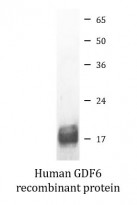ARG70099
Human GDF6 recombinant protein (Active) (His-tagged, C-ter)
Human GDF6 recombinant protein (Active) (His-tagged, C-ter) for SDS-PAGE
Overview
| Product Description | E. coli expressed, His-tagged (C-ter) Active Human GDF6 recombinant protein |
|---|---|
| Tested Application | SDS-PAGE |
| Target Name | GDF6 |
| Species | Human |
| A.A. Sequence | Thr336 - Arg455 |
| Expression System | E. coli |
| Activity | Active |
| Activity Note | Determined by its ability to induce alkaline phosphatase production by ATDC5 cells. The ED50 for this effect is 63-240 ng/mL. |
| Alternate Names | BMP13; SCDO4; KFS; KFS1; MCOP4; Growth/differentiation factor 6; Bone morphogenetic protein 13; SGM1; BMP-13; LCA17; Growth/differentiation factor 16; KFSL; KFM; GDF-6; CDMP2; MCOPCB6 |
Properties
| Form | Powder |
|---|---|
| Purification Note | Endotoxin level is less than 0.1 EU/µg of the protein, as determined by the LAL test. |
| Purity | > 98% (by SDS-PAGE) |
| Buffer | 20 mM sodium citrate and 0.2 M NaCl (pH 3.5) |
| Reconstitution | It is recommended to reconstitute the lyophilized protein in 4 mM HCl to a concentration not less than 200 μg/mL and incubate the stock solution for at least 20 min at room temperature to make sure the protein is dissolved completely. |
| Storage Instruction | For long term, lyophilized protein should be stored at -20°C or -80°C. After reconstitution, aliquot and store at -20°C or -80°C for up to one month. Storage in frost free freezers is not recommended. Avoid repeated freeze/thaw cycles. Suggest spin the vial prior to opening. |
| Note | For laboratory research only, not for drug, diagnostic or other use. |
Bioinformation
| Gene Symbol | GDF6 |
|---|---|
| Gene Full Name | growth differentiation factor 6 |
| Background | This gene encodes a member of the bone morphogenetic protein (BMP) family and the TGF-beta superfamily of secreted signaling molecules. It is required for normal formation of some bones and joints in the limbs, skull, and axial skeleton. Mutations in this gene result in colobomata, which are congenital abnormalities in ocular development, and in Klippel-Feil syndrome (KFS), which is a congenital disorder of spinal segmentation. [provided by RefSeq, Jul 2008] |
| Function | Growth factor that controls proliferation and cellular differentiation in the retina and bone formation. Plays a key role in regulating apoptosis during retinal development. Establishes dorsal-ventral positional information in the retina and controls the formation of the retinotectal map. Required for normal formation of bones and joints in the limbs, skull, and axial skeleton. Plays a key role in establishing boundaries between skeletal elements during development. May signal through the growth factor receptors subunits BMPR1A, BMPR1B, BMPR2 and ACVR2A. [UniProt] |
| Cellular Localization | Secreted. [UniProt] |
Images (1) Click the Picture to Zoom In






